Some people might see a GloFish and think that they’ve been injected or dyed so that they’ll glow with those crazy bright colors.
There used to be fish on the market that were called “painted” that had been injected with fluorescent dye. It was horrible and cruel, huge numbers of the fish died, the ones that lived had a shortened lifespan and the dye didn’t even last, it faded after several months.
But that’s NOT what GloFish are at all.
What are Glofish?
GloFish are actually a genetically modified organism (GMO). Scientists manipulated the genes of fish and added in genes from other organisms, like jellyfish and coral, to give GloFish their bright colors.
GloFish have the ability to fluoresce, meaning their skin can absorb light energy and then emit it back.
This functions just like glow-in-the-dark toys and decorations. Pigments in their skin get “charged” when light hits them.
Then, when they’re in a low light situation, they emit the light energy back out, making them glow.
Pro Tip: Blue aquarium lights, like the ones many aquarists run in their tanks at night, will make GloFish fluoresce brightly. It’s beautiful!
GloFish are a patented GMO, so technically, only the company that holds the patent (Spectrum Brands, Inc) is allowed to breed them and only approved vendors are allowed to sell them.
The original GloFish were all zebra danios, but now they have developed other species as well.
Popular Glofish And Care Information
Danios
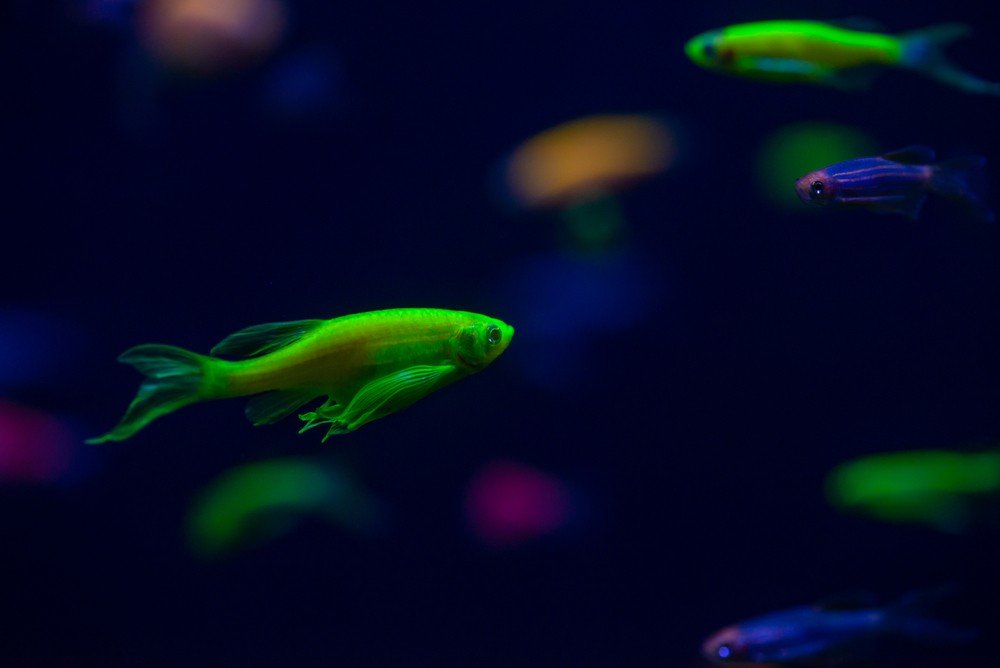
- Appearance: slim-bodied fish with short fins, faint stripes run from nose to tail with darker fins
- Min. Tank size: 10 gallons (38 liters)
- Type of tank: community
- Temperature: 64°-77°F (17.8°-25°C)
- Care level: easy
- Diet: omnivore
- Behavior: active, peaceful, schooling fish
- How many can be kept together: group of at least 5
- Size: 1.5-2 inches (4-5 centimeters)
GloFish danios were bred from zebra danios (Danio rerio). These are hyperactive little schooling fish that are a great addition to a community tank.
They’re an undemanding little fish that’s very hardy. They’ll happily eat crushed flake food, frozen daphnia and tubifex worms.
They absolutely need to be kept in a group of at least five but will do even better in a school of 10 or more.
Barbs
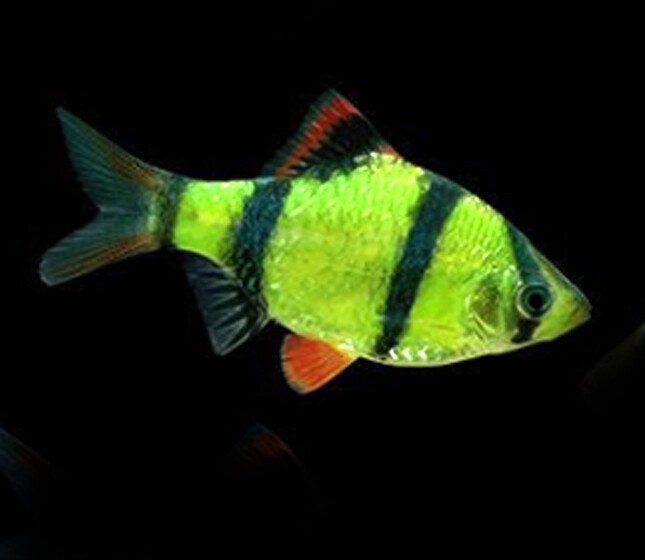
- Appearance: shaped like the head of a spear with small fins and black “tiger stripes”
- Min. Tank size: 20 gallons (76 liters)
- Type of tank: community tank with other fast-moving species
- Temperature: 70°-78°F (21°-25.6°C)
- Care level: easy
- Diet: omnivore
- Behavior: fast swimming schooling fish, sometimes semi-aggressive if kept in too small a group
- How many can be kept together: must be kept in a group of six or more
- Size: 2-3 inches (5-7.5 centimeters)
GloFish barbs are derived from the common tiger barb (Puntigrus tetrazona). They’re an active schooling fish that’s always interesting to watch as they swoop around the tank.
I especially like the contrast between their bright colors and black stripes.
Barbs are very hardy fish that will accept almost any kind of food.
They can get nippy with other species, but if you keep a large enough group of five or more, they’ll focus mainly on themselves and ignore other fish.
Tetras
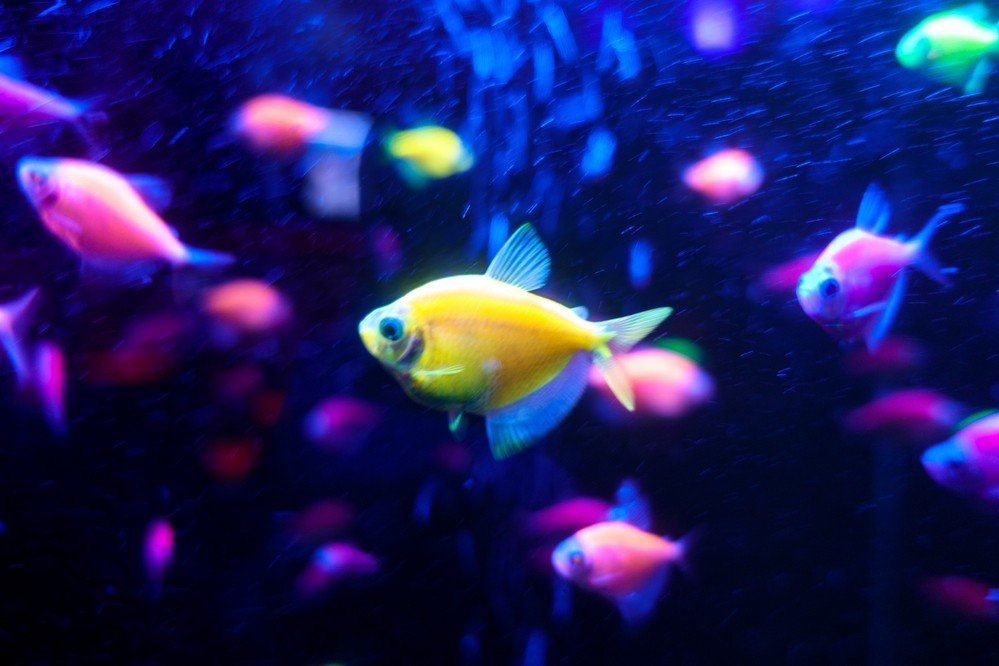
- Appearance: rounded forehead with deep chest and belly that quickly tapers down to their tails, large trailing anal fin
- Min. Tank size: 20 gallons (76 liters)
- Type of tank: peaceful community tank
- Temperature: 70°-79°F (21°-26°C)
- Care level: easy
- Diet: omnivore
- Behavior: peaceful schooling fish
- How many can be kept together: must be kept in a group of at least five or more
- Size: 2 inches (5 centimeters)
GloFish tetras are really eye catching as they swim by in a technicolor school.
They are a peaceful fish that’s great in a community tank, but they might nip the fins of slow-moving tank mates like Bettas. You should keep them in a school of at least five, but larger numbers are always better.
They’re very easy to care for and will readily accept flake, pelleted or frozen foods.
Sharks
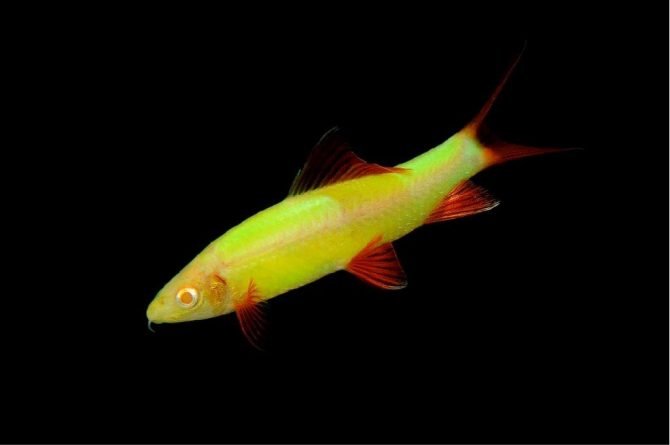
- Appearance: very slim bodied fish with small barbels on their faces and triangular fins that give them the same silhouette as many marine sharks
- Min. Tank size: 40 gallons (151 liters)
- Type of tank: fast-moving community
- Temperature: 72°-82°F (22°-28°C)
- Care level: easy
- Diet: omnivore
- Behavior: bottom dweller that hides a great deal but will pop out throughout the day
- How many can be kept together: only one per tank
- Size: 6 inches (15 centimeters)
Originally bred from rainbow sharks, GloFish sharks are the largest species so far. They require at least a 40 gallon tank, preferably with the biggest possible footprint.
GloFish sharks like to have a variety of hiding places to choose from. I’ve kept regular rainbow sharks for many years. I’ve found that they tend to hide more as they get older.
They need a sinking food like wafers or pellets.
They can be territorial and fiesty. I don’t think they’re a good choice for slow-moving, super peaceful fish because they can do a lot of chasing and bullying.
I’ve seen them get pushy and bossy with fish twice their size.
But, they’re a great choice for GloFish danios, tetras and barbs that are top dwellers and way too quick to be bothered by the shark.
Bettas
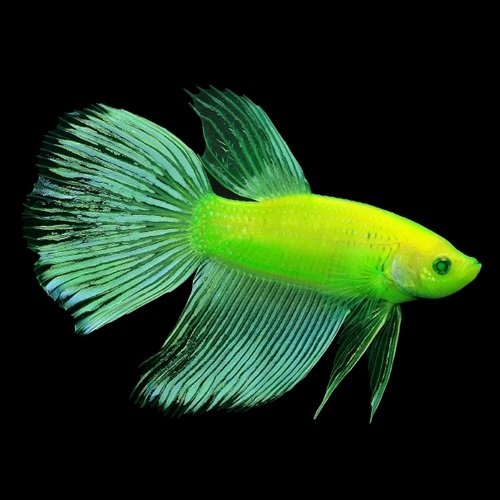
- Appearance: elongated body with a pointed snout and large showy fins
- Min. Tank size: 5 gallons (19 liters)
- Type of tank: species only tank is safest
- Temperature: 75°-80°F (24°-26.7°C)
- Care level: easy-intermediate
- Diet: carnivore
- Behavior: aggressive with its own kind, inquisitive fish with a feisty personality
- How many can be kept together: males must be kept singly, may be able to keep with other fish but it’s risky
- Size: 3 inches (7.5 centimeters)
Bettas are great little fish, they love to interact with their owners and you’ll love their spunky little personalities.
Males are territorial and will kill each other if more than one is put in the same tank.
You can sometimes mix males with fish of different species, but it can be risky and depends on the individual. It’s much safer to mix female bettas in a community tank.
It’s best to feed Bettas a commercially prepared pellet and give freeze dried bloodworms as a snack.
Pro Tip: Please, do not keep a Betta in a tiny cup or bowl. They need at least 5 gallons, some sort of filtration and a heater.
Conclusion
I think GloFish are really pretty, especially under blue lights. The first time I saw them, I almost couldn’t believe what I was seeing.
Those flashy colors are out of this world!
Also, they’re derived from really hardy species, so they’re good beginner fish.
I would just caution that some of the GloFish brand tanks are really small. Most of these species are schooling fish that will not be happy unless they’re kept in a fairly large group.
I would look at investing in at least a 20 gallon (76 liter) tank so you have enough room.
You can deck it out with all kinds of cool decor that will also react to the blue aquarium lights.
So you can have the best of both worlds: a super colorful tank that’s really unique and a healthy environment that’s just what the fish need.

HI, Your article is awsome!